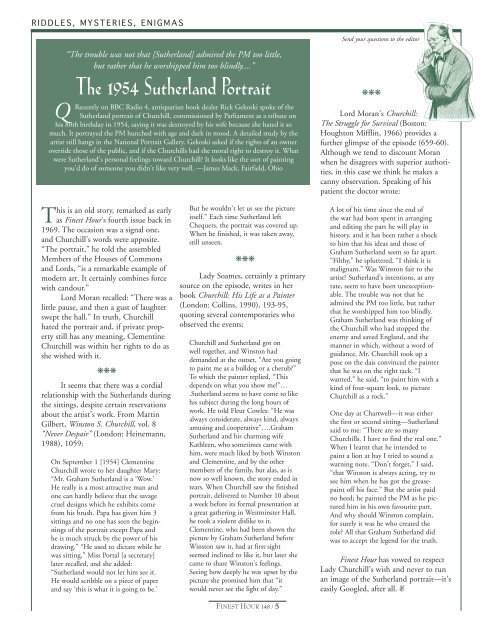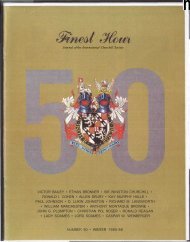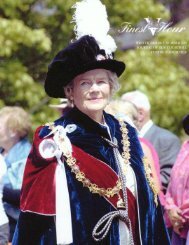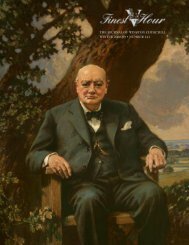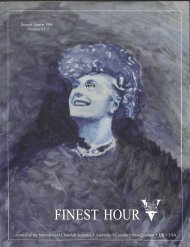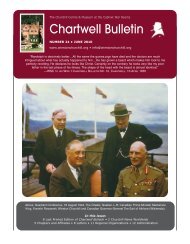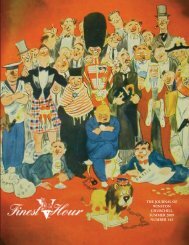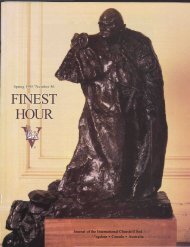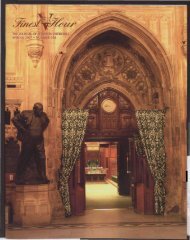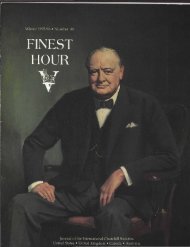You also want an ePaper? Increase the reach of your titles
YUMPU automatically turns print PDFs into web optimized ePapers that Google loves.
R I D D L E S , M Y S T E R I E S , E N I G M A S<br />
Q<br />
Recently<br />
“The trouble was not that [Sutherland] admired the PM too little,<br />
but rather that he worshipped him too blindly....”<br />
The 1954 Sutherland Portrait<br />
on BBC Radio 4, antiquarian book dealer Rick Gekoski spoke of the<br />
Sutherland portrait of <strong>Churchill</strong>, commissioned by Parliament as a tribute on<br />
his 80th birthday in 1954, saying it was destroyed by his wife because she hated it so<br />
much. It portrayed the PM hunched with age and dark in mood. A detailed study by the<br />
artist still hangs in the National Portrait Gallery. Gekoski asked if the rights of an owner<br />
override those of the public, and if the <strong>Churchill</strong>s had the moral right to destroy it. What<br />
were Sutherland’s personal feelings toward <strong>Churchill</strong> It looks like the sort of painting<br />
you’d do of someone you didn’t like very well. —James Mack, Fairfield, Ohio<br />
This is an old story, remarked as early<br />
as Finest Hour’s fourth issue back in<br />
1969. The occasion was a signal one,<br />
and <strong>Churchill</strong>’s words were apposite.<br />
“The portrait,” he told the assembled<br />
Members of the Houses of Commons<br />
and Lords, “is a remarkable example of<br />
modern art. It certainly combines force<br />
with candour.”<br />
Lord Moran recalled: “There was a<br />
little pause, and then a gust of laughter<br />
swept the hall.” In truth, <strong>Churchill</strong><br />
hated the portrait and, if private property<br />
still has any meaning, Clementine<br />
<strong>Churchill</strong> was within her rights to do as<br />
she wished with it.<br />
kkk<br />
It seems that there was a cordial<br />
relationship with the Sutherlands during<br />
the sittings, despite certain reservations<br />
about the artist’s work. From Martin<br />
Gilbert, <strong>Winston</strong> S. <strong>Churchill</strong>, vol. 8<br />
“Never Despair” (London: Heinemann,<br />
1988), 1059:<br />
On September 1 [1954] Clementine<br />
<strong>Churchill</strong> wrote to her daughter Mary:<br />
“Mr. Graham Sutherland is a ‘Wow.’<br />
He really is a most attractive man and<br />
one can hardly believe that the savage<br />
cruel designs which he exhibits come<br />
from his brush. Papa has given him 3<br />
sittings and no one has seen the beginnings<br />
of the portrait except Papa and<br />
he is much struck by the power of his<br />
drawing.” “He used to dictate while he<br />
was sitting,” Miss Portal [a secretary]<br />
later recalled, and she added:<br />
“Sutherland would not let him see it.<br />
He would scribble on a piece of paper<br />
and say ‘this is what it is going to be.’<br />
But he wouldn’t let us see the picture<br />
itself.” Each time Sutherland left<br />
Chequers, the portrait was covered up.<br />
When he finished, it was taken away,<br />
still unseen.<br />
kkk<br />
Lady Soames, certainly a primary<br />
source on the episode, writes in her<br />
book <strong>Churchill</strong>: His Life as a Painter<br />
(London: Collins, 1990), 193-95,<br />
quoting several contemporaries who<br />
observed the events:<br />
<strong>Churchill</strong> and Sutherland got on<br />
well together, and <strong>Winston</strong> had<br />
demanded at the outset, “Are you going<br />
to paint me as a bulldog or a cherub”<br />
To which the painter replied, “This<br />
depends on what you show me!”…<br />
.Sutherland seems to have come to like<br />
his subject during the long hours of<br />
work. He told Fleur Cowles: “He was<br />
always considerate, always kind, always<br />
amusing and cooperative”….Graham<br />
Sutherland and his charming wife<br />
Kathleen, who sometimes came with<br />
him, were much liked by both <strong>Winston</strong><br />
and Clementine, and by the other<br />
members of the family, but alas, as is<br />
now so well known, the story ended in<br />
tears. When <strong>Churchill</strong> saw the finished<br />
portrait, delivered to Number 10 about<br />
a week before its formal presentation at<br />
a great gathering in Westminster Hall,<br />
he took a violent dislike to it.<br />
Clementine, who had been shown the<br />
picture by Graham Sutherland before<br />
<strong>Winston</strong> saw it, had at first sight<br />
seemed inclined to like it, but later she<br />
came to share <strong>Winston</strong>’s feelings.<br />
Seeing how deeply he was upset by the<br />
picture she promised him that “it<br />
would never see the light of day.”<br />
Send your questions to the editor<br />
kkk<br />
Lord Moran’s <strong>Churchill</strong>:<br />
The Struggle for Survival (Boston:<br />
Houghton Mifflin, 1966) provides a<br />
further glimpse of the episode (659-60).<br />
Although we tend to discount Moran<br />
when he disagrees with superior authorities,<br />
in this case we think he makes a<br />
canny observation. Speaking of his<br />
patient the doctor wrote:<br />
A lot of his time since the end of<br />
the war had been spent in arranging<br />
and editing the part he will play in<br />
history, and it has been rather a shock<br />
to him that his ideas and those of<br />
Graham Sutherland seem so far apart.<br />
“Filthy,” he spluttered. “I think it is<br />
malignant.” Was <strong>Winston</strong> fair to the<br />
artist Sutherland’s intentions, at any<br />
rate, seem to have been unexceptionable.<br />
The trouble was not that he<br />
admired the PM too little, but rather<br />
that he worshipped him too blindly.<br />
Graham Sutherland was thinking of<br />
the <strong>Churchill</strong> who had stopped the<br />
enemy and saved England, and the<br />
manner in which, without a word of<br />
guidance, Mr. <strong>Churchill</strong> took up a<br />
pose on the dais convinced the painter<br />
that he was on the right tack. “I<br />
wanted,” he said, “to paint him with a<br />
kind of four-square look, to picture<br />
<strong>Churchill</strong> as a rock.”<br />
One day at Chartwell—it was either<br />
the first or second sitting—Sutherland<br />
said to me: “There are so many<br />
<strong>Churchill</strong>s. I have to find the real one.”<br />
When I learnt that he intended to<br />
paint a lion at bay I tried to sound a<br />
warning note. “Don’t forget,” I said,<br />
“that <strong>Winston</strong> is always acting, try to<br />
see him when he has got the greasepaint<br />
off his face.” But the artist paid<br />
no heed; he painted the PM as he pictured<br />
him in his own favourite part.<br />
And why should <strong>Winston</strong> complain,<br />
for surely it was he who created the<br />
role All that Graham Sutherland did<br />
was to accept the legend for the truth.<br />
Finest Hour has vowed to respect<br />
Lady <strong>Churchill</strong>’s wish and never to run<br />
an image of the Sutherland portrait—it’s<br />
easily Googled, after all. ,<br />
FINEST HOUR 148 / 5


